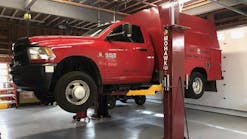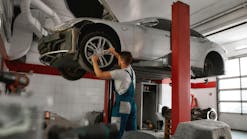The Autoflow visual workflow and communication solution for the auto repair industry keeps shop personnel and customers updated throughout the stages of the vehicle repair process via an easy-to-use dashboard. Autoflow automates text message communication from the shop to the customer and saves time for everyone, from service writers whose time can be utilized more efficiently, to customers who are kept informed and can better plan their day, according to the company. Expedited communication can result in greater customer satisfaction, reduced wasted rack time and higher shop productivity.
The Review
Tommy Keeter, a Christian Brothers Automotive franchise owner located in Tulsa, Okla., initially sought out the Autoflow website for use in his nine-bay shop.
“I was sold on it. I had heard about the idea and I called (the company) because I was ready to give it a try.”
To set up the website, the company accessed Keeter’s system and once the website was ready to go, they set up a tutorial for Keeter’s team. “It’s very, very simple,” Keeter says. “The whole process maybe took a total of 30 minutes of our time.”
“The owner of the company is a shop owner and you can tell that. He’s walked through the process that anybody working in a shop would have to navigate so he’s eliminated a lot of potential hiccups, in my opinion.”
Keeter says his shop uses this tool for every type of repair except when the customer is waiting at the shop, for example: an oil change or alignment.
“Everything else is checked in this way,” he says, referring to customer vehicles. “When a customer comes in, we ask if they would prefer to be updated via text messages." Occasionally, Keeter says there will be someone who isn’t “of the texting generation” but that it’s rare. Customers who prefer not to be contacted via text message can still be alerted by the shop by telephone.
Autoflow is integrated with RO Writer, a software program that Keeter uses to store customer information and history, so when a customer pulls into the shop, Keeter is able to click over to the autotext.me screen and enter the customer’s phone number. Autotext.me then auto populates with customer and vehicle information.
The website is easy to use and it offers an instant line of communication between the service team and customers. Keeter says, “(Autoflow) is set up with our shop email, so if a customer texts us back, it alerts us on our shop email. As long as you stay tuned to everything, you get instant feedback.”
He likes that the autotext.me offers customizable messaging. He doesn’t feel constrained to automatic texts. He also says this has allowed his team to make the website fit their workflow process instead of changing the workflow process to make it work for them.
Keeter says one of the benefits of this product is that the customers appreciate this form of communication. “You’re not calling and interrupting them. They’re still able to go about their own life, it’s just a quick text and that’s huge. We’re able to communicate with customers in a much timelier manner than just doing phone calls.”
Keeter uses this website to communicate with customers throughout the entire repair process. “There’s probably seven or eight messages that we go through. When we have a report back from the technician, we say (to the customer), ‘Please call the shop.’” Keeter adds that he finds some conversations need to be held over the phone and that this tool is not meant to replace personal contact. “I don’t think it will every replace a phone call, nor should it.”
Keeter says there are two things he would like to improve about the tool. The first is that Autoflow limits message length to 160 characters. Although this was an adjustment, Keeter knows and understands the reasoning behind it. “We’ve just learned to adapt to it. You can send two messages if you have to, it’s not a big deal.”
The second thing that Keeter believes would enhance the tool would be the ability to write multi-inspection reports within the tool to then send to customers. “That would be huge.”
Although there are a few updates that Keeter would like to see in the future, he says that the company has been great about taking feedback and improving capabilities of the tool.
“One example is when you would close out a customer, you could no longer communicate with (them). If you had a customer who came back with feedback, like a check engine light came back on, you wouldn’t have been able to reply to them. Now, you can.”
Keeter says an additional benefit his shop didn’t anticipate was the positive customer reaction to the integration of this tool. Customers appreciate being communicated with via text message. "They basically put your shop in a different category as far as communication goes.”
“It grows their respect for us. From a consumer standpoint, they feel incredibly well taken care of.” He adds, “Typically, customers feel under communicated with, whereas with this tool, they feel adequately, or almost over communicated with, which I would definitely prefer. We send updates every couple of hours.”



